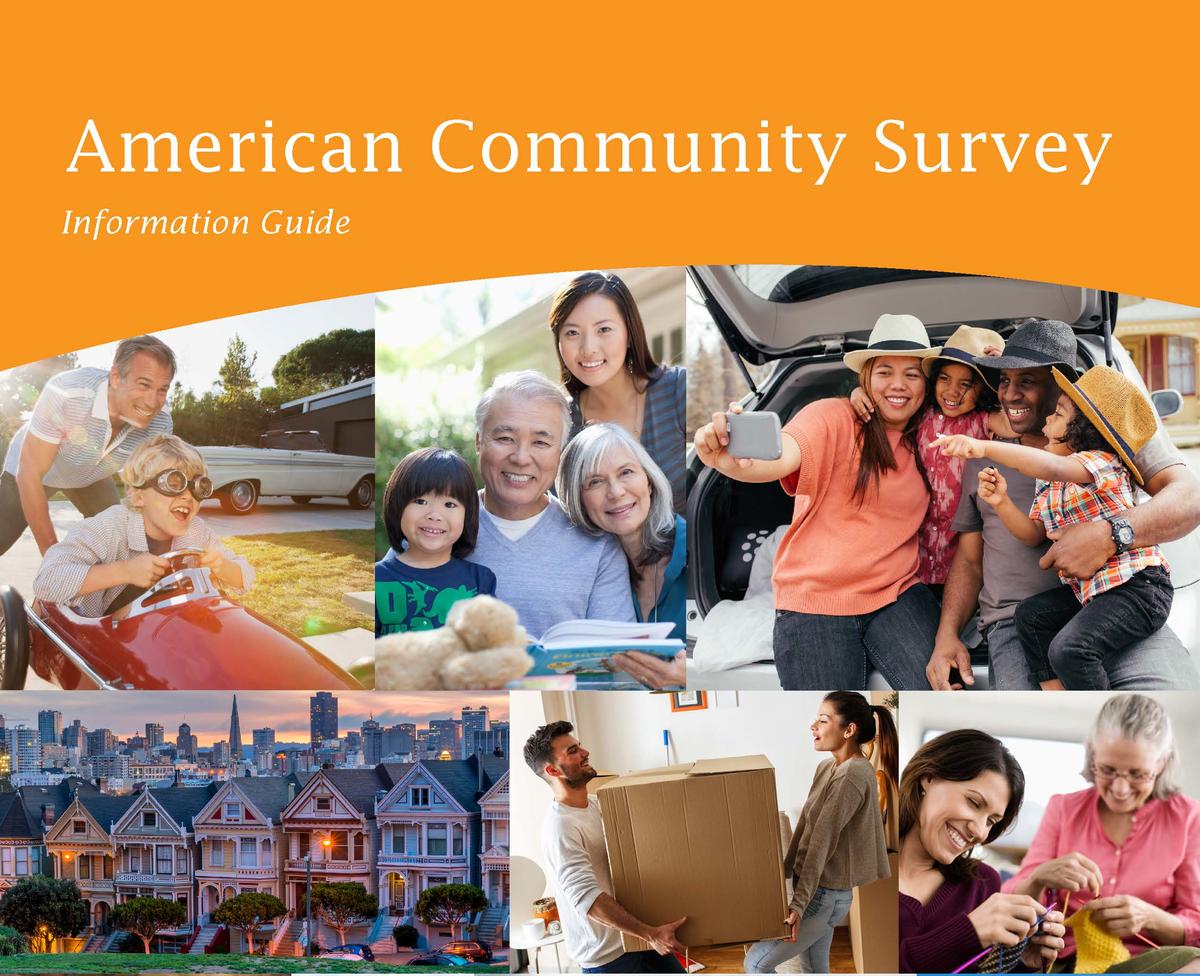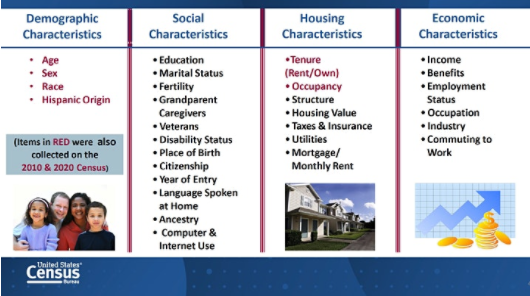Having accurate data is necessary to making decisions about most anything we do. Do you comparison shop when purchasing items? That uses gathered data. Do you budget for your family or business? That uses gathered data. On a much more grand scale, gathered socio-economic data helps make key decisions affecting states, cities, businesses, schools, health care and so much more—decisions that can affect us in some way. What happens if that necessary data isn’t collected any longer?
The American Community Survey (ACS) is a survey distributed annually by the United States Census Bureau that helps provide data on key socio-economic information to members of Congress, federal agencies, state and local planners, nonprofit organizations, journalists, educators, businesses, and the general public.
The ACS provides a wealth of information on small geographic regions—like cities, counties, and zip codes—that is not available through any other source. Figure 1 provides examples of the type of data that is available from the ACS. Items in black are available from that source alone, while items in red are available from the decennial census.
Because of the detailed nature of the data available from the ACS, it is widely used by businesses, educators, journalists, and the public at large, not to mention government and tribal agencies to better understand and advocate for their communities. For example, if an engineering business is trying to decide where to open another office, it might look for a location with a high concentration of people employed in engineering occupations. Similarly, nonprofit organizations use ACS to produce reports and research papers that may be used to apply for funding to help support grants for community projects. On the local level, planners and policymakers use ACS data to assess needs for services such as hospitals, schools, and other businesses.
Earlier this year, Minnesotans for the American Community Survey (MACS)—a coalition of Minnesota policy makers, business leaders, educators, and citizens who advocate for the importance of ACS data—collected stories from 26 organizations throughout the state that use the ACS in their work, including multiple chambers of commerce, university research centers, economic development agencies, and private businesses. Many reported using ACS data for market research, to apply for grant funding to help support community projects, or to assess needs for services such as hospitals, schools, and other businesses.
“ACS data is invaluable in reviewing the past, current and future needs of our workforce.” – Jonathan Weinhagen, President & CEO of Minneapolis Regional Chamber
“Our program provides economic and demographic information for the entire region, and the regular updates to the ACS ensure that we present the most accurate picture possible.” – Karl Shuettler, Research Director & Senior Consultant for The Northspan Group Inc.
“Without the ACS, we would have no way to measure population change, household income, characteristics of owner and renter households, and other areas of information that inform policy strategy and investment decisions.” – Michael Peterson, Data & Research Analyst for the City of Minneapolis Community Planning and Economic Development
“Without it, communities would not have the data businesses require to make decisions.”-Neal Young, Economic Analysis Director for the Department of Employment and Economic Development
“Without census data, the Minnesota Department of Health has no way of accurately tracking disease rates or risk.” –Melissa Finnegan, Director, Legislative Relations for the Minnesota Department of Health
In 2021, the Census Bureau announced that it would not release its standard 2020 ACS one-year estimates and that it was delaying the release of the 2016-2020 American Community Survey (ACS) five-year data—both due to the impact of COVID-19 on data collection. The five-year estimates, originally slated to be released in December 2021, were just finally released in March. According to the Census Bureau, the final response rate for the ACS was 71%—the lowest it has been since the ACS started in 2005. But perhaps more concerning, ACS response rates have been steadily declining since 2014 (96.7%). Lower response rates put the survey at risk of being eliminated, which would mean an end to the valuable information currently provided from this source. In 2012 Congress passed a budget bill to eliminate the American Community Survey altogether. While that bill was unsuccessful, it highlights the vulnerability of the ACS.
The good news is that, in Minnesota, the work being done by MACS and other partner organizations, has resulted in some of the highest response rates for both the decennial census and the ACS nationwide. For the 2020 ACS, Minnesota had the tenth highest response rate (79%) of all states. The work that MACS did to encourage participation in the 2020 decennial census also led to Minnesota retaining a 2021 Congressional seat. If New York had received responses from 89 more people in the 2020 Census, it would have been awarded the final Congressional seat over Minnesota. Because of Minnesota’s success encouraging participation in the 2020 census and improving response rates for the ACS, many experts in community organizing have come to refer to MACS and the advocacy work that the group did as the “Minnesota Model.”
We at the BBER rely heavily on the ACS data. The data helps us provide a much more accurate statistical report for our city, state, public, and private clients and their constituencies. Many of these clients utilize our research for initiatives that have far-reaching implications affecting not only state programs and decisions but also regional and federal. Some recent BBER projects that have utilized ACS data include:
The Regional Economic Indicators Forum (REIF)
This ongoing, comprehensive research initiative helps drive growth, prosperity and collaboration across the 15-county REIF region in Northeast Minnesota and Northwest Wisconsin.
Salvation Army Needs Assessment
The Salvation Army of Duluth had been examining its need for a new location by conducting needs assessments in 2012 and 2017. The BBER’s 2021 report built upon the past assessments’ results, summarizing key demographic and socioeconomic data for geographic areas within Duluth.
The Impact of Split Incentive on Privately Owned UMD Student Rental Housing
This multi-year project dove deeply into the cost of implementing energy efficient improvements in rental housing. It provided insight into the economic impact on the city of Duluth if a focused program addressing the issue was enacted. The BBER study has been shared both regionally and state-wide by many entities.
You can help protect the ACS, so its data can continue to be collected and used.
- Become a supporter by filling out this form found on the MACS website
- Respond to the ACS if invited to fill out the survey
- Learn about how it affects your own community and educate others on its importance

